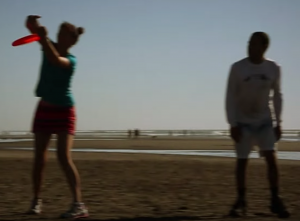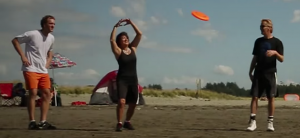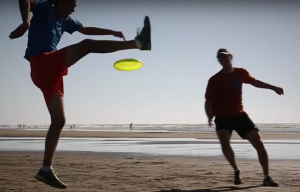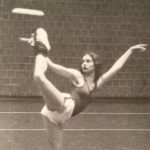 Jamming is the art of spontaneous play with the disc and with friends. It connects people with a common purpose while bringing them fully into the moment. It seems like a place where rules should not exist. Yet some of my favorite jams, jams where I learned the most have had limits artificially set on them.
Jamming is the art of spontaneous play with the disc and with friends. It connects people with a common purpose while bringing them fully into the moment. It seems like a place where rules should not exist. Yet some of my favorite jams, jams where I learned the most have had limits artificially set on them.
One such jam, I like to call Hoop Factory. It was beach weekend and there were at least 10 of us on the sand. As we walked to our spot on the beach we could feel that the wind was perfect. It was going to be a good day. Someone grabbed a disc and a few of us began to warm up. A little speed flow, a few hoops, lights Zzzs. Then someone said, “let’s make a rule that we can’t catch it until it’s been hooped at least three times.” “Sure, that sounds fun,” was my reply.
It started innocently. Hoop the throw, hoop a set, hoop to a catch. Nothing complicated. It was almost like running in sand, everything was labored. As people joined the jam, they were informed of the rules. Wait, do leg overs count? SURE!
 Soon the whole crew was on one disc and things were beginning to flow. It no longer felt forced. Instead everyone was moving and finding hoops we didn’t know were possible. 3 people would hoop one pass. People would hoop other people’s self sets. People got closer together. Sets where higher and longer. All 10+ of us on one disc, and it never felt slow.
Soon the whole crew was on one disc and things were beginning to flow. It no longer felt forced. Instead everyone was moving and finding hoops we didn’t know were possible. 3 people would hoop one pass. People would hoop other people’s self sets. People got closer together. Sets where higher and longer. All 10+ of us on one disc, and it never felt slow.
At one point there was a high roll across set coming to me. As I targeted the disc a 5 person hoop tunnel formed. I could see the disc clearly through the tunnel, still not yet entering. I lined up for a phlaud and watched the disc float through the tunnel, into my hand.
 Eventually the game dissipated, the jam split into a few groups and the day went on. But wow, what a game. My hooping skills went up multiple levels that day. I now see hoop opportunities constantly. I highly encourage you to implement Hoop Factory in one of your jams.
Eventually the game dissipated, the jam split into a few groups and the day went on. But wow, what a game. My hooping skills went up multiple levels that day. I now see hoop opportunities constantly. I highly encourage you to implement Hoop Factory in one of your jams.
Of course, Hoop Factory is just one idea. There certainly can be many more. Maybe only use one spin. Maybe ban the nail delay. A one touch rule? A small disc? A big disc? 2 discs anyone? I’ve tried all these and more and every time I learn something new and have fun in the process.
Any one else have any jam rules you’ve implemented? I’d love to hear about it.



 Bad attitude is named after the dance position called attitude, except it’s a bad version of it. I am the perfect example of how bad the attitude can be. My flexibility is limited so the
Bad attitude is named after the dance position called attitude, except it’s a bad version of it. I am the perfect example of how bad the attitude can be. My flexibility is limited so the  Of course when I do it, it’s not so pretty. But, when done properly, it can be quite beautiful. Here’s Sue Straight showing us a proper bad attitude. Don’t worry if you don’t look like Sue. The bad attitude is a fun, explosive, and surprising catch that will grab attention no matter your form.
Of course when I do it, it’s not so pretty. But, when done properly, it can be quite beautiful. Here’s Sue Straight showing us a proper bad attitude. Don’t worry if you don’t look like Sue. The bad attitude is a fun, explosive, and surprising catch that will grab attention no matter your form.

